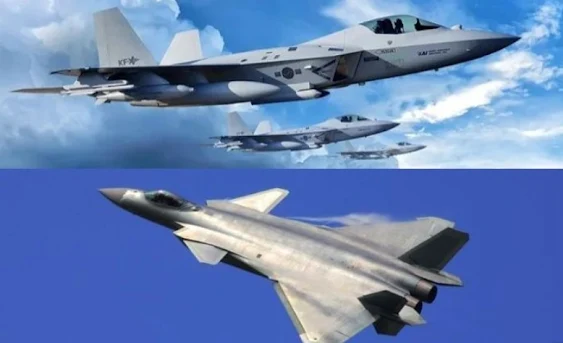 |
| Korean KF-21 Boramae Fighter Jets And China's J-20 Fighter Jets |
International Military - Having just made its maiden flight, the KF-21 Boramae is already in doubt about its ability to compete with China's Chengdu J-20. Technology This fighter aircraft itself is said to still have very limited stealth capabilities.
Chinese media said the KF-21 Boramae was not a competitor to the J-20 fighter. This news emerged after the fighter plane made its maiden flight some time ago.
Quoted from ABS CBN, South Korea is working on a new fighter plane as it tries to catch up with China and Russia. But military observers believe South Korea's KF-21 Boramae fighter jet is far from comparable to advanced fifth-generation fighters such as China's Chengdu J-20.
However, if deployed en masse, the KF-21 could still change the regional air force balance of power. And also the KF-21 Boramae has the potential to be a strong competitor in the global market, said a Macau-based analyst.
South Korea hopes its domestically made four-plus generation fighter will serve as a cheaper alternative to the imported US Lockheed Martin F-35 Lightning II, and also aims to promote it in the international arms market. Its developer, Korea Aerospace Industries, even announced upgrade plans to eventually modify the jet into a stealth fighter.
Only the United States, China and Russia currently have combat-ready fifth-generation fighters, the US F-22 and F-35, China's J-20 and Russia's Su-57, which combine stealth, super maneuverability, supersonic cruising, and advanced avionics.
The main characteristics of all fifth-generation fighters are the optimized surface design and weapons storage in the internal chamber to reduce radar reflection and maintain stealth capability.
However, although the KF-21 Boramae's aerodynamic design adopted many of the features of a stealth fighter, test flights showed that it carried four missile models on external hard points, demonstrating very limited stealth capabilities.
The American KF-21 Boramae's F414-GE-400K engine is also a clear shortcoming, as its power will not match the needs of fifth-generation fighters for supercruise and maneuverability.
Nonetheless, with advanced avionics such as an active electronically scanned array (AESA) radar, electro-optical targeting pods, infrared search and tracking systems, and a capable arsenal including air-to-air and air-to-surface missiles, the KF-21 meets requirements to become a modern fourth generation or four-plus fighter.
The Chengdu J-10 is a fourth-generation Chinese-made multi-role fighter that was introduced in 2005, with hundreds now in service. As a single-engine jet, the J-10 is relatively narrower and lighter than the KF-21 Boramae, and its newest variants, the J-10B and J-10C, are also equipped with advanced avionics such as AESA radar, electro-optical targets. infrared sensors and seekers, and they also carry powerful weapons.
The Shenyang FC-31 is China's second fifth-generation fighter, which made its first test flight in 2012 and is still under development. Both the KF-21 Boramae and FC-31 are medium twinjet fighters, with similar sizes and specifications, and even some similarities in their silhouettes.
The Korean jet is designed for a top speed of Mach 1.8, the same as the FC-31. Their gun payloads are 7.7 tonnes and 8 tonnes, with combat ranges of 1,450 km (900 miles) and 1,200 km, respectively.
If it performs well, the KF-21 Boramae might pose some threat to China, given the US-South Korea military alliance, Wong added. He predicts direct competition between the KF-21 Boramae and FC-31 in the international market, adding that it is positioned in the same niche as the US F-16 series, Russian Su-57 and Turkish TF-X.
Reporting from Yonhap News, the KF-21 Boramae developed by South Korea and Indonesia successfully carried out its first flight test on Tuesday, July 19, 2022.
The KF-21 Boramae fighter successfully flew six and a half years after its giant development project began despite doubts over technological barriers, cost effectiveness and other feasibility questions.
At the Air Force's 3rd Flying Training Wing in Sacheon, about 300 kilometers south of Seoul, the fighter took off. That means South Korea will join an elite club of seven nations that have developed a supersonic fighter jet locally. KF-21 Boramae took off at 3:40 p.m. and landed at 4:13 p.m. for its first air test, according to DAPA.
